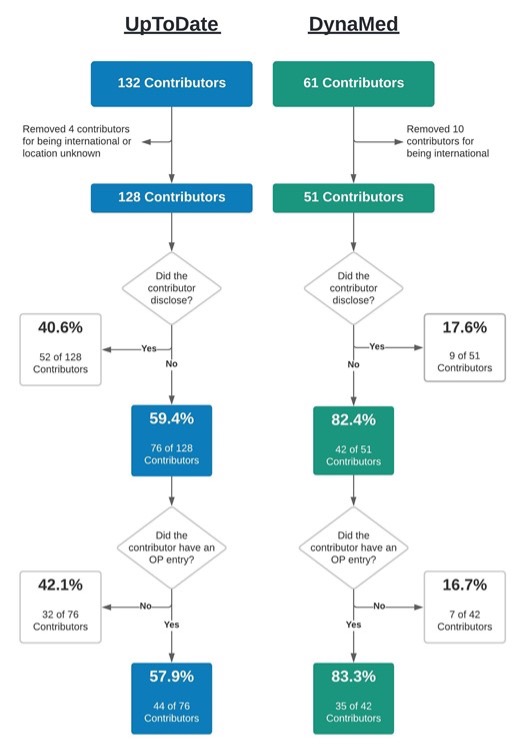
06 Jul Geisinger Study Found 79 Physician Contributors to UpToDate and DynaMed with Potential Conflicts of Interest of Nearly $8 Million
MedicalResearch.com Interview with:

SooYoung VanDeMar
SooYoung VanDeMark, MBS
Geisinger Commonwealth School of Medicine
Scranton, Pennsylvania
MedicalResearch.com: What is the background for this study?
Response: Health care providers utilize subscription-based, point-of-care databases such as DynaMed and UpToDate to provide clinical care guidance and remain current on the latest evidence-based findings. Both of these websites maintain this content through a cadre of physician contributors who write and edit articles for these sites. These physician contributors are required to self-report any conflicts of interest (COI) as outlined by the respective policies on each website. However, prior COI research into similarly self-regulated areas, such as medical and pharmacology textbooks, and clinical practice guidelines, has found both appreciable potential COI and inconsistencies between self-reported and industry mandated disclosures (1-3).
This study (4) explored the accuracy of physician contributors to DynaMed and UpToDate by comparing their self-reported disclosure status with the financial remunerations they received from the healthcare industry (e.g., pharmaceutical companies) as reported to the U.S. Centers for Medicare and Medicaid Services’ Open Payments database. Physician contributors who reported “nothing to disclose” on their respective article topic but had an entry on Open Payments for having received money from industry, were classified as discordant and, thus, as having the potential for a COI. Additionally, total remuneration, gender, and payment category were investigated more in depth for each database.
MedicalResearch.com: What are the main findings?
Response: Of the 179 physician contributors reviewed, also shown in the figure, from 84 articles on UpToDate and DynaMed, 134 had received financial payments (> $10) from a healthcare manufacturer between 2013-2018, with a sum total of $77.7 million. The majority ($68.1 million) of which having been received by the UpToDate physician contributors. Forty-four of 128 UpToDate contributors were found to be discordant, with a sum total of nearly $5 million and a median remuneration of $3,608. Similarly, 35 of 51 DynaMed physician contributors were discordant with a sum total of nearly $3 million and a median remuneration of $1,403.
The contributors who received the top ten largest amounts from industry for each database were further examined. The top ten individual earners who contributed content to UpToDate accounted for a sum of $56 million, were all men, and only one person was found discordant. The top ten individual earners who contributed content to DynaMed received a sum of nearly $9 million, eight were men, and six were discordant. When reviewing these seven discordant authors and their article contents, we found one instance of a specific brand name being used in an article to which the assigned discordant contributor had received $4,695 from that drug/medical device manufacturer.
Of the 179 contributors reviewed, 50 were women. Women contributors to UpToDate and DynaMed received 2.5% and 17.3%, respectively, of the total remuneration from the healthcare industry. Women contributing to UpToDate were statistically less likely to have an Open Payments entry than men (chi-square = 24.32, p < .001). However, there was no gender difference among DynaMed contributors.

MedicalResearch.com: What should readers take away from your report?
Response: An appreciable amount of industry money was received by physician contributors to both DynaMed ($3 million) and UpToDate ($5 million) who self-reported nothing to disclose in their article. It is possible that such payments could have resulted in a COI, biasing the content provided by these popular, evidence-based medical websites. These websites are utilized by health care providers in providing clinical care. This paper’s findings of rates of discordance are similar to a different investigation of content contributors to Medscape, another online medical database (1). Quantifiable research in the areas of bioethics, medical authorship, and COIs needs to continue.
MedicalResearch.com: Is there anything else you would like to add?
Response: This report adds to a large body of evidence that self-reported COI should be treated with substantial skepticism (1, 3). The U.S. Centers for Medicare and Medicaid Services’ Open Payments database is easy to use. We recommend health care providers, journalists, and patients regularly verify any self-reported COIs. We would also encourage point-of-care database editors to complement self-reported disclosures with a prominently placed link to Open Payments for every contributor in order to sustain the reader’s trust that these resources have maintained the highest ethical standards.Citations
- Chopra AC, et al. Quantification of conflicts of interest in an online point-of-care clinical support website. Science & Engineering Ethics. 2020; 26(2):921-930.
- Piper BJ, et al. Undisclosed conflicts of interest among biomedical textbook authors.
American Journal of Bioethics: Empirical Bioethics. 2018; 9(2):59-68. doi: 10.1080/23294515.2018.1436095.
- Baraldi JH, et al. A cross-sectional examination of conflict-of-interest disclosures of physician-authors publishing in high-impact US medical journals. BMJ Open. 2022; 12(4):e057598.
- VanDeMark SYH, et al. Examination of potential industry conflicts of interest and disclosures by contributors to online medical resource databases. JAMA Network Open. 2022; 5(7):e2220155. doi: 10.1001/jamanetworkopen.2022.20155.The information on MedicalResearch.com is provided for educational purposes only, and is in no way intended to diagnose, cure, or treat any medical or other condition. Always seek the advice of your physician or other qualified health and ask your doctor any questions you may have regarding a medical condition. In addition to all other limitations and disclaimers in this agreement, service provider and its third party providers disclaim any liability or loss in connection with the content provided on this website.
Last Updated on July 6, 2022 by Marie Benz MD FAAD
